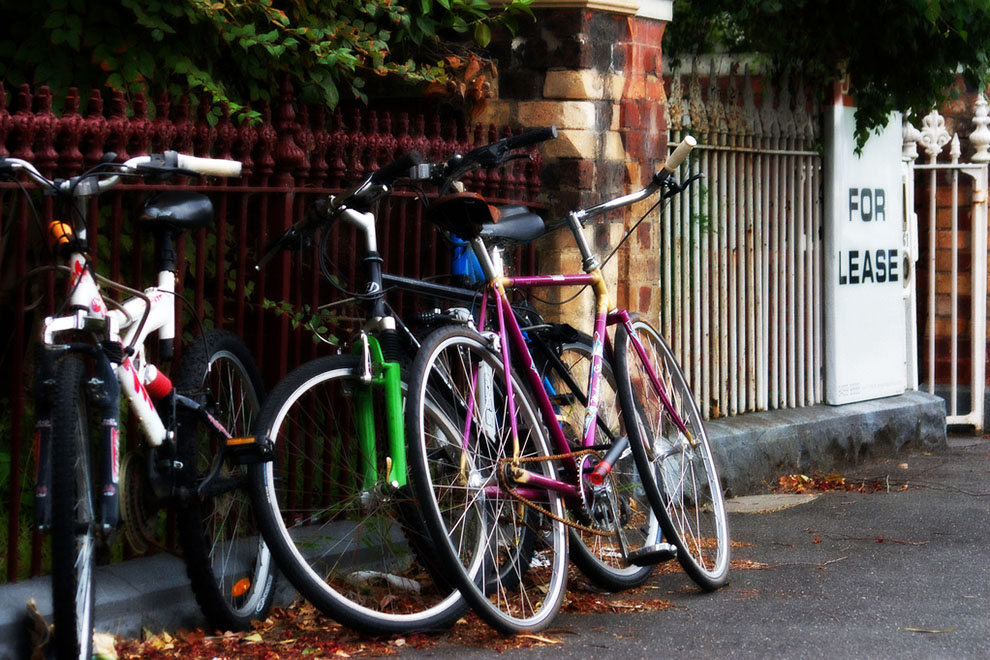In her twenties, Alice Jaques lived in pokey little student flats in inner-Melbourne suburbs like Kensington and North Carlton while she finished her doctoral research in public health at Melbourne University. Most days she walked to work.
In 2005 she married Jason Osborne, an IT professional who worked in a city bank, and they began planning a future with children and their own home. They didn’t even bother looking in the inner city. Alice’s friends told her “it would be six, seven [hundred thousand dollars]-plus for anything decent.”
Alice’s sister lived in Point Cook, a new suburb twenty-five kilometres southwest of the CBD. It was growing fast, with new shops, schools and childcare centres. The couple liked what they saw. They bought off the plan and in a couple of years moved into their four-bedroom home. They caught the Werribee train to work, and life was good.
Then Alice had their first child, William, and took nine months off. When she went back to work two days a week, Jason took three months’ paternity leave. After he returned to work, they enrolled William in the new childcare centre at nearby Sanctuary Lakes while Alice continued her part-time job.
The two days Alice worked were hectic. She woke at 5 am so she could get to work at the Murdoch Children’s Research Institute by 7 am. (Jason dropped William at childcare at about 8 am on his way to work.) This allowed Alice to leave for home at 3.30 pm. She was anxious to keep William’s days in childcare as short as possible.
Naturally, problems sometimes occurred. On one day, Alice left around her usual finish time to get back to Point Cook and pick up William. But at North Melbourne station she heard announcements that trains were suspended indefinitely on the Werribee line. There were replacement buses, but she was already imagining the crush to get on board. By now it was after 4.30, and the childcare centre closed at 6.30 sharp. Alice “began freaking out.” She called Jason at his CBD office. They made a snap decision to brave the traffic in a taxi. The fare cost $90.
With the birth of their second child, Lucy, Alice again took nine months maternity leave, then returned to work. Jason again took paternity leave for three months. During that time they decided that their carefully calibrated “tag-in, tag-out” arrangement was unsustainable.
They assessed options, laid out spreadsheets on the dining room table, pored over the weekly budget. Could they afford to live on one salary and keep up the mortgage? If Alice continued to work as before, Jason would have to get two kids off to childcare during peak hour. He’d probably get to work even later than 10 am. As well as it taking longer to get two kids out of the house, Point Cook’s growing population and increasing traffic congestion had by that point doubled the time it took Jason to drive to the train. He also had to park further away from the station. Would it hurt his career?
There was also the high cost of childcare, which would eat into Alice’s salary. But the logistics – the traffic, the limited public transport, the exhausting distances – proved to be the clincher. Remembering that day at North Melbourne station, the frantic taxi ride, Alice gave notice to her employer. For the foreseeable future, her career in public health was over.
She tried to keep her hand in with some university teaching, tutoring in genetics a couple of times a year. But she found it too hard to keep abreast of developments in her field of prenatal screening for birth defects. On the other hand, she was over-qualified for most jobs that came up around Point Cook.
The family lives more frugally since Alice stopped working in public health. Their last proper family holiday was three years ago, though sometimes they go camping. Two days a week Alice works at William’s primary school. She collects a half-day’s salary for teaching sewing classes, and dabbles in a sewing business from home. Perhaps she’ll consider getting a teaching qualification herself once Lucy starts school, so she can work part-time while staying close for school pick-up.
One thing they won’t do is move from Point Cook. The community spirit is strong, and Alice loves the place. But for all its positives, she is clear that if she lived closer to the city she would not have been forced into the trade-off that cut short her career.
The Osbornes are typical of millions caught on the far side of the new urban divide changing Australia and challenging longheld ideals of economic opportunity and fairness. This is the growing gap between people who live near the centre of Australian cities and those who live near the outer fringes.
The two groups experience city life very differently. For those on the wrong side of the divide, poorer access to jobs affects their ability to maintain and build a career over time, and long commutes are expensive and exhausting. In some cases, commutes can make juggling the responsibilities of home and work so difficult that some – usually women – have to give up work altogether.
Employees living furthest from the centre of Australia’s five biggest cities also get paid less. The average yearly individual income among employees living within ten kilometres of Australia’s five largest cities is a quarter higher than that of employees living more than twenty kilometres from city centres.
In Sydney, the highest-earning twenty-five to sixty-four-year-olds are clustered around the inner suburbs, Sydney Harbour and the North Shore. Typical incomes in Bondi, by the sea, and St Ives, in the north, are also comparatively high, above $60,000. Incomes in western suburbs such as Bankstown and Wetherill Park are typically below $40,000. In Brisbane, typical individual incomes are highest – above $60,000 a year – among people living near the centre in places such as Bulimba or Ashgrove, and in well-located riverside suburbs. Incomes in more distant suburbs are typically below $40,000.
The income gap between inner and outer suburbs is growing. Since the mid 1990s, income growth among people living in suburbs close to city centres – Alexandria in Sydney, for example, and Albert Park in Melbourne and Morningside in Brisbane – has been 3 or 4 per cent a year (adjusted for inflation). Incomes in the west and southwest of Sydney, the far southeast and northwest of Melbourne and in the southern suburbs of Brisbane suburbs have barely grown over the same period.
The changes are reshaping cities, the opportunities they offer and their very identity. Living north or south of the Yarra River used to be Melbourne’s biggest class marker. The working class lived in the north, the well-heeled in the east and the south. But people on high incomes have increasingly clustered in inner suburbs on both banks of the river. In Brisbane the economic and cultural divide between people living north and south of the Brisbane River is eroding, with proximity to the city centre increasingly desirable.
The pattern is less pronounced in Perth, where incomes have grown strongly across the metropolitan region, a legacy of the recent mining boom. Perth’s smaller manufacturing base also means the decline of that sector has not hit the city as hard. Nevertheless, income growth is still highest close to the city centre.
Part of the reason outer suburban residents earn lower incomes is that they are more likely to be employed casually in lower-skilled roles. Casual employees account for almost half of all sales workers and labourers in outer suburbs but fewer than 10 per cent of the management and professional jobs concentrated in city centres. The average weekly wage of casual workers Australia-wide is $538 per week, less than half the average weekly full-time wage of $1276. Almost a third of casual employees are underemployed and want to work more hours.
Differences in wealth, or assets, can give a more meaningful indication of people’s material living standards than differences in income. For example, a retiree may have a low annual income despite having accumulated extensive assets during a long career. It is difficult to get an accurate geographic breakdown of wealth in Australia, but we can use house prices as a rough proxy for wealth distribution in Australia’s big cities.
The highest property prices are increasingly found in suburbs close to the CBD. Households with the greatest levels of wealth congregate in the parts of cities with the best access to jobs and transport. The further you go from city centres, the more house prices fall. The declines in house prices as you get further from the CBD are steepest in Sydney and Melbourne, the two cities with the greatest concentrations of knowledge-intensive jobs in the inner city. They are also the cities that sprawl furthest and offer the worst access to jobs.
Of course, access to jobs and transport are just two factors in creating a person’s wealth; education and skill levels are also vital. A strong link now exists between skill levels and where people live. University graduates are concentrated in Melbourne’s inner suburbs, for example, and in some middle suburbs east of the city centre. Outer suburbs have lower shares of university graduates. And the closer residents live to city centres, the greater the number and range of high-skilled jobs they can reach by car, bicycle, foot or public transport, which better services the inner city.
There are many stories like Alice’s. In common with a great number of people who live far from city centres, she isn’t reaping the full material benefits that living in a city should bring, benefits that previous generations of Australian city residents enjoyed before the new divide set in. There are a number of ways this division can be broken down; here, we’ll focus on one key area for change.
Enabling people to live closer to jobs and transport, and to choose the kind of home they want, means that more homes need to be built – especially semi-detached terraces, units and townhouses, and low-rise flats – in established inner and middle suburbs.
Critics of greater inner-urban density sometimes conjure up images of downtown Shanghai, or of high-rise apartment towers dwarfing suburban homes. But well-designed new housing, close to jobs and transport, can be found in Potts Point in Sydney, South Yarra in Melbourne, New Farm in Brisbane and Subiaco in Perth, among other places. These are some of Australia’s most populated areas, but they are also desirable and often prestigious places to live.
The benefits of giving people more housing options are considerable. Households wouldn’t get everything they want, but a wider range of choices would make a great difference to many people’s lives. The whole community benefits, too. Enabling people to live closer to jobs would contribute to economic growth by giving people a wider choice of jobs and employers a better choice of employees. And if new housing doesn’t get built in places with good access to jobs, it will continue to be built in areas with poor access to jobs, exacerbating the growing social and economic divide.
The biggest barrier to new housing near employment centres is the system of state and local government rules and processes that dictate where and how new housing is built. The complexity and delay built into these processes can make getting permission to construct new housing expensive and uncertain, and frequently impossible. Dramatically simplifying and streamlining these processes is an urgent priority.
Less complexity shouldn’t mean lower standards, though. In fact, higher standards are essential if the community is to accept a simpler, faster and less costly system.
Local residents’ interests are protected by arbitrary barriers that slow down all proposals to build housing and make them more costly or completely unviable. A better way to achieve clearer and higher standards is through clear codes or standards that determine approval for more kinds of home development. Housing codes can protect existing residents from badly designed developments while reducing the costs of planning approval processes.
Compliance with the code could be assessed by a builder, surveyor or consultant, and permission to build would not have to be sought through an authority such as a local council. This doesn’t mean a free-for-all: buildings that are later found not to comply with the code can be demolished or modified at the developer’s expense, with substantial penalties for the professional who endorsed it. Alternatively, planning approval could be granted by an authority such as a local council, but through an accelerated process.
Codes would cover aspects of the scale and appearance of buildings and how they integrate into a street. These include height and overshadowing in outdoor areas, privacy and the appearance of new developments from the street. They would also cover internal features, such as how much sunlight can enter living areas, and the amount of private open space. Homes that comply with the relevant housing code will be well designed and respect neighbourhood character.
Some state governments are using these kinds of code already, but largely for detached houses or in limited locations. They are not yet enabling the mix of housing in the mix of locations that people want. Applying housing codes to all residential areas would make a big difference to the availability of a variety of new housing.
Sometimes governments call existing rules and processes “codes” but allow for a lot of discretion and uncertainty in practice. If codes are to offer certainty, developers and builders should not have discretion over whether to apply them. Local communities’ interests should be respected from the start by the government involving them in developing the housing code that applies to their area. In most cases communities shouldn’t need to go to a tribunal or court to enforce local rules.
Ministerial interventions in the approval process for individual developments erode the trust local residents have in the system, giving them little reassurance that their interests will be respected. Planning ministers should decide the content of the rules, guided by deep community engagement. Indeed, they have a democratic mandate to do so. But they should not be the umpire as well.
And, as the NSW Independent Commission Against Corruption points out, clarity and simplicity also reduce the risk of corruption.
To succeed, any change needs to work for existing residents of established suburbs, as well as for prospective residents and the city as a whole. Genuine engagement is essential to achieving change that ensures everyone has their interests respected, even though not everybody will get everything they want.
The first step is citywide engagement to allocate responsibility for managing population change and building new homes across the city. This should reflect the broader needs of the city and the interests of all its residents. Plans should identify where new housing will be built, and what new transport connections are required to improve residents’ access to jobs. If the plans are based on good engagement that creates a real sense of community ownership they will also help different levels of government and different organisations work in the same direction, rather than opposing developments for short-term political gain.
To turn the plan into reality, each local council must have realistic housing targets. Every area needs to accommodate its share of population growth. Housing targets can distribute growth fairly and encourage local councils not to think only about short-term benefits to local residents at the expense of people living elsewhere in the city.
Local communities can then agree on how to meet their housing target in a way that works best for their area. As in Vancouver and Seattle, local residents should decide on design guidelines that are sensitive to the existing character of their neighbourhood. Buildings that can house the same number of households can be made to look and feel very different.
The community should also be involved in deciding what mixes of housing should go where, so that different types of household can live in the area, including older downsizers, young couples, families and single-person households. Finally, issues that existing residents rightly care about – such as maintenance of privacy, minimisation of overlooking and overshadowing, and placement of garages – should be built into local codes.
State governments have a critical role to play. They have the authority to push local councils to stick to their housing targets. They can require local plans to include enough land zoned to allow new housing. They can offer praise and extra funding to those that are succeeding, while naming and shaming laggards, and if necessary applying financial penalties.
In line with citywide plans, state governments also need to ensure more housing is accompanied by better transport. Depending on the location, this could involve more infrastructure, or better ways to manage congestion and parking. These transport improvements need to be paid for and implemented, not promised then forgotten. Otherwise, geography will increasingly be destiny. •
This is an edited extract from City Limits: Why Australia's Cities are Broken and How We Can Fix Them.




